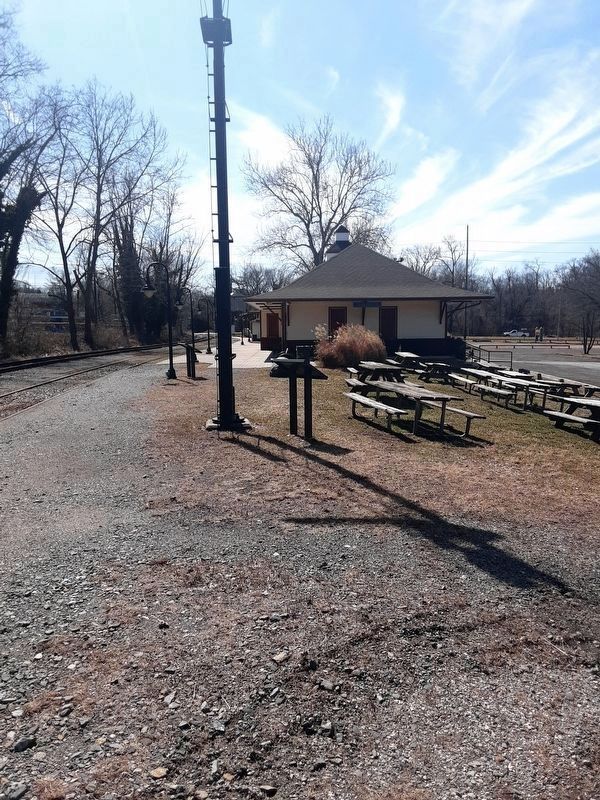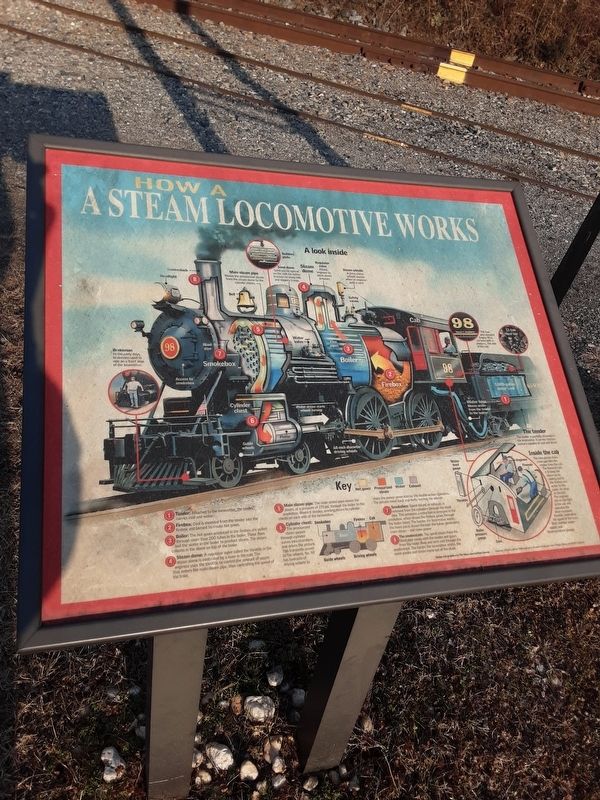Woodland near Wilmington in New Castle County, Delaware — The American Northeast (Mid-Atlantic)
How a Steam Locomotive Works
A look inside
[On the large picture of the locomotive, labels are here listed left to right; for labels within a column, list from top to bottom.]
-Brakeman -- In the early days, brakemen used to ride on a front step of the locomotive.
-Headlight
-(8) Smokestack
-Access to Smokebox
-Blast pipe
-(7) Smokebox
-Main steam pipe -- Moves the pressurized steam from the stean dome to the cylinder chests.
-Bell
-(5) Hot gases
-(6) Cylinder chest
-Guide wheels
-Piston
-Builders plate
-Sand dome -- Sand can be spread on the rails for better traction on steep hills and slippery tracks.
-Water valve
-Piston action starts wheels turning
-(4) Steam dome
-Regulator valve -- Allows engineer to adjust steam pressure.
-Flue pipes
-68-inch diameter driving wheels
-(3) Boiler
-Steam whistle -- A three-chime whistle sounds when an engineer pulls a cord.
-Safety valves
-(2) Firebox
-Cab
-98 Thomas C. Marshall Jr. -- The man who donated Engine 98 is honored with a plaque on the side of the cab.
-Water hose -- Moves water from the tender to the boiler.
-(1) 5,000-gallon water tank
-12-ton coal bin
-N & WEST
The tender
The tender is partially attached to the locomotive. It carries the locomotive`s supplies of coal and water.
Inside the cab
The two-person train crew operates the engine from the cab. The fireman's job is to keep the volume up by loading coal to the firebox and water to the boiler. He stays on the left. The engineer sits on the right in the cab and operates the steam pressure throttle, controlling the speed of the train. Both monitor water-supply and steam-pressure gauges.
[Just left of "Inside the cab" is a circle containing these labels, clockwise from top:]
-Engineer
-Fireman
-Coal
-Boiler pressure gauge
-Throttle
-Water level gauge
Key
Hot gases [,] Pressurized steam [,] Water [,] Exhaust
(1) Tender: Attached to the locomotive, the tender carries coal and water.
(2) Firebox: Coal is shoveled from the tender into the firebox and burned to create hot gases.
(3) Boiler: The hot gases produced in the firebox are pulled through more than 200 tubes in the boiler. These flues boil the water in the boiler to produce steam. The steam collects in the dome on top of the boiler.
(4) Steam dome: A regulator valve called the throttle in the steam dome is controlled by a lever in the cab. The engineer uses the throttle to control the amount of steam that

Photographed By Carl Gordon Moore Jr., March 19, 2021
2. How a Steam Locomotive Works Marker
In background is the Greenbank station building. In the foreground, directly in front of the left of the building, is this ("How a Steam Locomotive Works") plaque. Further back, next to a light standard, and not as far back as the building, is the "What Is This?" plaque.
(5) Main steam pipe: The main steam pipe moves the steam, at a pressure of 175 psi, through the boiler to the smokebox, where it divides, sending steam to cylinder chests on each side of the locomotive.
(6) Cylinder chest: The pressurized steam passes through cylinder valves into chambers and drives the pistons. This transmits power to the wheels. No. 98 has two sets of driving wheels to share the power generated by the double-action cylinders. The pistons move back and forth turning the wheels.
(7) Smokebox: Spent steam, or exhaust, is released from the cylinders through the blast pipe. This produces a reduction in pressure in the smokebox, which draws the firebox gases through the boiler tubes. The harder the locomotive works, the more gas is drawn through the tubes generating more steam - and more power.
(8) The smokestack: The spent steam from the blast pipe mixes with the smoke and gases from the boiler flues and both exit through the smokestack. The harder the locomotve works, the more smoke and steam come out of the stack.
[labels on small sketch of locomotive:] Smokebox [,] Firebox [,] Cab [,] Guide wheels [,] Driving wheels
Design and graphics by The News Journal / Dan Garrow
Sources: David Ludlow, Wilmington & Western Railroad, How Things Work, and Mitch Goldman
Topics. This historical marker is listed in this topic list: Railroads & Streetcars.
Location. 39° 44.344′ N, 75° 37.923′ W. Marker is near Wilmington, Delaware, in New Castle County. It is in Woodland. Marker can be reached from Greenbank Road. This is on the grounds of the Wilmington & Western Railroad. It is near the railroad track to south of Greenbank Road, near the "What Is This?" plaque, which is to the south of this plaque, and Greenbank station, which is south of that other plaque. Touch for map. Marker is in this post office area: Wilmington DE 19808, United States of America. Touch for directions.
Other nearby markers. At least 8 other markers are within walking distance of this marker. What Is This? (here, next to this marker); Wilmington & Western Railroad (about 400 feet away, measured in a direct line); Greenbank Mill (about 400 feet away); The Lynching of George White (about 600 feet away); The "Annie Oakleys": First Female Prison Guards in the United States (about 800 feet away); Fells Mill Historic District (approx. 0.7 miles away); The Home of William Julius "Judy" Johnson (approx. ¾ mile away); Camp DuPont (approx. ¾ mile away). Touch for a list and map of all markers in Wilmington.
Credits. This page was last revised on February 13, 2023. It was originally submitted on March 12, 2021, by Carl Gordon Moore Jr. of North East, Maryland. This page has been viewed 158 times since then and 23 times this year. Photos: 1. submitted on March 12, 2021, by Carl Gordon Moore Jr. of North East, Maryland. 2. submitted on March 20, 2021, by Carl Gordon Moore Jr. of North East, Maryland. • Bill Pfingsten was the editor who published this page.
